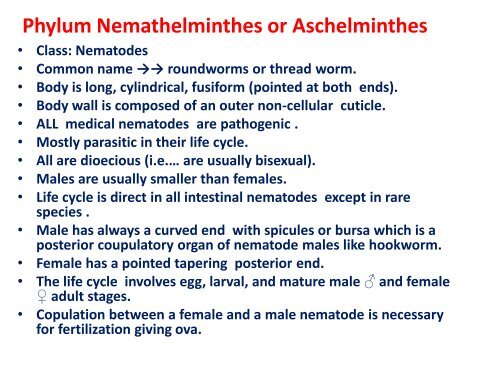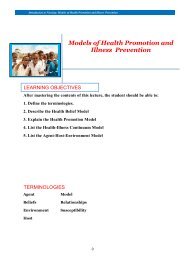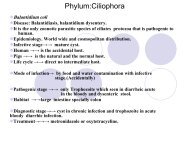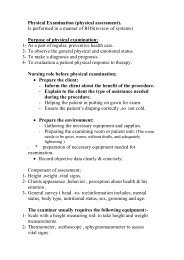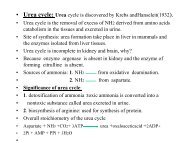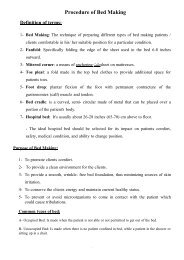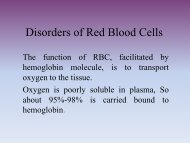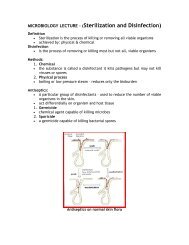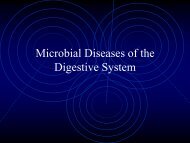Phylum Nemathelminthes or Aschelminthes
Phylum Nemathelminthes or Aschelminthes
Phylum Nemathelminthes or Aschelminthes
You also want an ePaper? Increase the reach of your titles
YUMPU automatically turns print PDFs into web optimized ePapers that Google loves.
<strong>Phylum</strong> <strong>Nemathelminthes</strong> <strong>or</strong> <strong>Aschelminthes</strong><br />
• Class: Nematodes<br />
• Common name →→ roundw<strong>or</strong>ms <strong>or</strong> thread w<strong>or</strong>m.<br />
• Body is long, cylindrical, fusif<strong>or</strong>m (pointed at both ends).<br />
• Body wall is composed of an outer non-cellular cuticle.<br />
• ALL medical nematodes are pathogenic .<br />
• Mostly parasitic in their life cycle.<br />
• All are dioecious (i.e.… are usually bisexual).<br />
• Males are usually smaller than females.<br />
• Life cycle is direct in all intestinal nematodes except in rare<br />
species .<br />
• Male has always a curved end with spicules <strong>or</strong> bursa which is a<br />
posteri<strong>or</strong> coupulat<strong>or</strong>y <strong>or</strong>gan of nematode males like hookw<strong>or</strong>m.<br />
• Female has a pointed tapering posteri<strong>or</strong> end.<br />
• The life cycle involves egg, larval, and mature male ♂ and female<br />
♀ adult stages.<br />
• Copulation between a female and a male nematode is necessary<br />
f<strong>or</strong> fertilization giving ova.
Intestinal nematodes: 1-Enterobius vermicularis <strong>or</strong> (Oxyuris vermicularis )<br />
• Common name →→ pinw<strong>or</strong>m <strong>or</strong> seat w<strong>or</strong>m <strong>or</strong> oxyuris .<br />
• Disease →→Pinw<strong>or</strong>m <strong>or</strong> seat w<strong>or</strong>m infection <strong>or</strong> enterobiasis<br />
• Adult shape is pin like with both <strong>or</strong>al cuticle alae.<br />
• Infective stage →→ fully developed and mature ova.<br />
• Ova plano-covex in shape <strong>or</strong> D-Shaped ova.<br />
• Ova found in dirt under the nails and in household dust.<br />
• (Adult females: 8 to 13 mm, adult male: 2 to 5 mm.) .<br />
• Habitat →adults in the rectum, anus, colon.<br />
• Modes of infection →1- contamination of food and water 2-inhalation 3- retroinfection.<br />
4-auto-infection<br />
• Symptoms<br />
• Many people with pinw<strong>or</strong>m infections have no symptoms and may never be aware<br />
of the infection. The infection can go away without treatment<br />
• Itching around the anal region.<br />
• female migrate after mid night from intestine to peri anal region what is called<br />
nocturnal migration to lay eggs causing pruritic and perianal itching, sleeping<br />
disturbances.<br />
• Diagnosis →→Rarely found in stool. Perianal swab by cellulose adhesive tape<br />
technique to see ova under microscope.<br />
• Treatment → antihelminthics <strong>or</strong> anthelmintic drug Mebendazole.
Pinw<strong>or</strong>m life cycle<br />
ova Life cycle
2- Trichuris trichiura<br />
• Common name →whipw<strong>or</strong>m.<br />
• Disease → whipw<strong>or</strong>m infection <strong>or</strong> Trichuriasis.<br />
• Adult w<strong>or</strong>ms measure approximately 4 cm whip like w<strong>or</strong>m<br />
• Female longer than male.<br />
• Egg is barrel shaped with bipolar plugs <strong>or</strong> American football-shaped.<br />
• Adult habitat →→ cecum, appendix, colon and rectum.<br />
• Infective stage →→ fully developed ova<br />
• Mode of infection →contamination of food and water WITH MATURE OVA.<br />
• Life cycle is direct.<br />
• Reservoir host → dogs as well as human.<br />
• Symptomes →→Generally asymptomatic.<br />
• Heavy infestations may have bloody diarrhea.<br />
• blood loss may lead to iron-deficiency anemia.<br />
• Rectal prolapse is possible in severe cases.<br />
• Diagnosis→→ by finding ova and adult in the GSE.<br />
• Vitamin A deficiency may also result due to infection.<br />
• Treatment →→The drug of choice f<strong>or</strong> trichuriasis is mebendazole (90%<br />
effective in the first dose)
Life cycle of Trichuris trichiura
3-Ascaris Lumbricoides<br />
• Disease → Giant round w<strong>or</strong>m infection <strong>or</strong> Ascariasis.<br />
• Adult w<strong>or</strong>ms measure approximately up to 30 cm<br />
• Female longer than male.<br />
• Adult habitat →live s in the lumen of the small intestine.<br />
• Infective stage → fully developed fertilized ova.<br />
• Unfertilized eggs may be ingested but are not infective.<br />
• Mode of infection →Ingestion of food contaminated with<br />
eggs.<br />
• Life cycle is direct with heart lung migration<br />
• Adults causes bloating, stomach pains, loss of appetite,<br />
nausea, vomiting and bloody stools.<br />
• During lung migration patient shows signs and symptoms<br />
similar to asthma <strong>or</strong> pneumonia.<br />
• Diagnosis →→ stool samples f<strong>or</strong> ova.<br />
• Drugs such as Mebendazole, Albendazole can eliminate these<br />
parasitic roundw<strong>or</strong>ms out of your body
Life cycle of Ascaris
4- Ancylostoma duodenale<br />
• Disease → old w<strong>or</strong>ld hook w<strong>or</strong>m infection <strong>or</strong> Ancylostomiasis<br />
• commonly known→ As Old W<strong>or</strong>ld hookw<strong>or</strong>m.<br />
• It lives in the small intestine of hosts such as humans, cats and dogs.<br />
• it is → dioecious . Males are 8 mm to 11 mm long with a copulat<strong>or</strong>y bursa at the<br />
posteri<strong>or</strong> end. Females are 10 mm to 13 mm long, with the vulva located at the<br />
posteri<strong>or</strong> end; females can lay 10,000 to 30,000 eggs per day.<br />
• Ancylostoma duodenale→ cosmopolitan in distribution.<br />
• Infective stage → filarif<strong>or</strong>m larva<br />
• Mode of infection→ by skin penetration by larva from contaminated soil.<br />
• Route of infection → skin.<br />
• Life cycle →direct. When a filarif<strong>or</strong>m larva (infective stage) penetrates the intact<br />
skin, the larva enters the blood circulation. It is then carried to the lungs, coughed<br />
up, and swallowed back into the small intestine.<br />
• Symptoms → usually vary acc<strong>or</strong>ding to the severity of infection.<br />
• Heavy infections may cause a person to become anemic due to w<strong>or</strong>ms feeding on<br />
the host’s blood. while iron deficiency anemia might result in mental dullness and<br />
heart failure<br />
• Occasionally coughing and upper respirat<strong>or</strong>y tract infections.<br />
• Diagnosis → by finding ova in fresh stool <strong>or</strong> rhabditif<strong>or</strong>m larva.<br />
• Prevention → wearing shoes <strong>or</strong> not waking with barefoot on dirty soil.<br />
• Treatment→ mebendazole <strong>or</strong> vermox.
Mouth and L.C<br />
Hook like anteri<strong>or</strong> end of A.D Life cycle of A. duodenala


